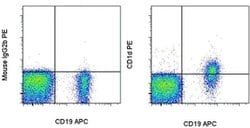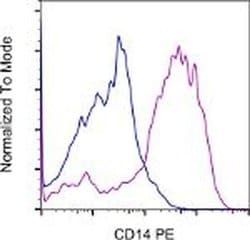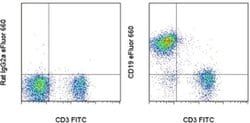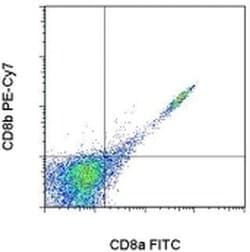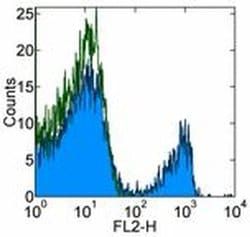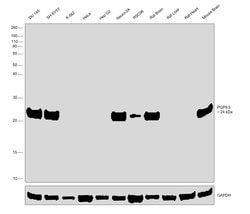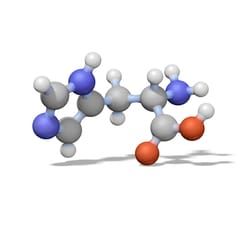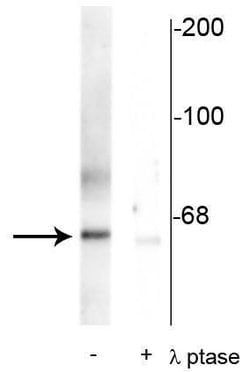CD1d Monoclonal Antibody (1B1), eFluor™ 450, eBioscience™, Invitrogen™
Manufacturer: Invitrogen
Select a Size
| Pack Size | SKU | Availability | Price |
|---|---|---|---|
| Each of 1 | 48-001-182-Each-of-1 | In Stock | ₹ 31,061.00 |
48-001-182 - Each of 1
In Stock
Quantity
1
Base Price: ₹ 31,061.00
GST (18%): ₹ 5,590.98
Total Price: ₹ 36,651.98
Antigen
CD1d
Classification
Monoclonal
Concentration
0.2 mg/mL
Formulation
PBS with 0.09% sodium azide; pH 7.2
Gene Accession No.
P11609
Gene Symbols
Cd1d1
Purification Method
Affinity chromatography
Regulatory Status
RUO
Gene ID (Entrez)
12479
Content And Storage
4° C, store in dark, DO NOT FREEZE!
Form
Liquid
Applications
Flow Cytometry
Clone
1B1
Conjugate
eFluor 450
Gene
Cd1d1
Gene Alias
AI747460; Antigen-presenting glycoprotein CD1d; antigen-presenting glycoprotein CD1d1; Cd1; CD1.1; CD1A; Cd1d; CD1D antigen; CD1D antigen, d polypeptide; CD1d molecule; CD1d.1; Cd1d1; CD1d1 antigen; CD1d1 molecule; differentiation antigen CD1-alpha-3; HMC class I antigen-like glycoprotein CD1D; Ly-38; R3; R3G1; T-cell surface glycoprotein CD1d; T-cell surface glycoprotein CD1d1; thymocyte antigen CD1D
Host Species
Rat
Quantity
100 μg
Primary or Secondary
Primary
Target Species
Mouse
Product Type
Antibody
Isotype
IgG2b κ
Description
- Description: The 1B1 monoclonal antibody reacts with mouse CD1d, a 48 kDa glycoprotein with structural homology to MHC class I molecules
- While similar to MHC Class I, CD1d associates with beta2m, functionally CD1d is similar to MHC Class II
- 1B1 detects CD1d at varying levels on mouse leukocytes
- 1B1 detects beta2m associated CD1d
- Applications Reported: This 1B1 antibody has been reported for use in flow cytometric analysis
- Applications Tested: This 1B1 antibody has been tested by flow cytometric analysis of mouse splenocytes
- This can be used at less than or equal to 0.25 μg per test
- A test is defined as the amount (μg) of antibody that will stain a cell sample in a final volume of 100 μL
- Cell number should be determined empirically but can range from 10^5 to 10^8 cells/test
- It is recommended that the antibody be carefully titrated for optimal performance in the assay of interest
- eFluor™ 450 is an alternative to Pacific Blue™
- eFluor™ 450 emits at 445 nm and is excited with the Violet laser (405 nm)
- Please make sure that your instrument is capable of detecting this fluorochome
- Excitation: 405 nm; Emission: 445 nm; Laser: Violet Laser
- Filtration: 0.2 μm post-manufacturing filtered
- CD1d is a heavy chain associated with Beta 2 microglobulin on cortical thymocytes
- Beta 2 microglobulin independent expression of CD1d has also been demonstrated on human intestinal epithelial cells
- CD1d is the sole group 2 member of the CD1 family of major histocompatibility (MHC) like glycoproteins
- The CD1d gene encodes a divergent member of the CD1 family of transmembrane glycoproteins, which are structurally related to the major histocompatibility complex (MHC) proteins and form heterodimers with beta-2-microglobulin
- The CD1 proteins mediate the presentation of primarily lipid and glycolipid antigens of self or microbial origin to T cells
- The human genome contains five CD1 family genes organized in a cluster on chromosome 1
- The CD1 family members are thought to differ in their cellular localization and specificity for particular lipid ligands
- The protein encoded by the CD1d gene localizes to late endosomes and lysosomes via a tyrosine-based motif in the cytoplasmic tail
- Diseases associated with CD1D include Mycobacterium Malmoense and Autoimmune Disease.

